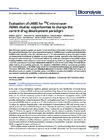Evaluation of cAMS for 14C microtracer ADME studies: opportunities to change the current drug development paradigm
Abstract
Aim: Although regulatory guidances require human metabolism information of drug candidates early in the development process, the human mass balance study (or hADME study), is performed relatively late. hADME studies typically involve the administration of a 14C-radiolabelled drug where biological samples are measured by conventional scintillation counting analysis. Another approach is the administration of therapeutic doses containing a 14C-microtracer followed by accelerator mass spectrometry (AMS) analysis, enabling hADME studies completion much earlier. Consequently, there is an opportunity to change the current drug development paradigm. Materials & methods: To evaluate the applicability of the MICADAS–cAMS method, we successfully performed: the validation of MICADAS–cAMS for radioactivity quantification in biomatrices and, a rat ADME study, where the conventional methodology was assessed against a microtracer MICADAS–cAMS approach. Results & discussion: Combustion AMS (cAMS) technology is applicable to microtracer studies. A favorable opinion from EMA to complete the hADME in a Phase I setting was received, opening the possibilities to change drug development. Show more
Permanent link
https://doi.org/10.3929/ethz-b-000252746Publication status
publishedExternal links
Journal / series
BioanalysisVolume
Pages / Article No.
Publisher
Future ScienceSubject
14C; cAMS; clearance; combustion accelerator mass spectrometry; human ADME; Leniolisib; mass balance; metabolism; MICADAS; microtracerOrganisational unit
08619 - Labor für Ionenstrahlphysik (LIP) / Laboratory of Ion Beam Physics (LIP)
More
Show all metadata





